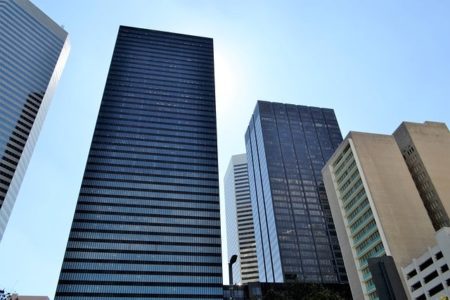Commercial real estate (Commercial property )refers to properties that are used primarily for business, income-generating, or commercial purposes, rather than for residential living. These properties are specifically designed to accommodate and support various commercial activities, businesses, and organizations.
Commercial real estate includes a wide range of property types, such as office buildings, retail spaces, industrial warehouses, multifamily properties, hotels, medical buildings, and more. These properties are either leased or sold to businesses, investors, or individuals for income generation, business operations, or investment purposes.
Investing in commercial real estate can be attractive due to the potential for rental income, appreciation in property value, and the opportunity to diversify one’s investment portfolio. However, commercial real estate investments often require careful consideration, due diligence, and understanding of the market dynamics and property management.
Commercial real estate transactions typically involve leasing, buying, or selling these properties to generate income or support business operations. The commercial real estate market is influenced by factors like economic conditions, demographics, industry trends, and government regulations. It plays a crucial role in supporting businesses, providing space for economic activities, and driving investment opportunities for individuals and corporations alike.
Here are types of commercial real estate;
- Office buildings;
- Larger apartment buildings (five units and more);
- Industrial complexes,
- Retail shopping centers,;
- Warehouses;
- Medical offices;
- Mobile home parks;
- Retail stores;
- Restaurants;
- Manufacturing plants;
- Storage units;
- Power centers;
- Gas stations;
- Trailer parks;
- Marinas;
- Hotels, motels, resorts, and the list goes on…

What are the major types of commercial real estate?
Office Buildings : A structure providing environments that are conducive to the performance of management and administrative activities, accounting, marketing, information processing, consulting, human resources management, financial and insurance services, educational and medical services, and other professional services. At least 75 percent of the interior space is finished to accommodate office users, but the rest of the space can include other uses such as retail, restaurant or fitness
Office buildings are usually loosely grouped into one of three categories: Class A, Class B, or Class C.
- Class A Building A classification used to describe an office building with rents in the top 30 to 40 percent of the marketplace. Class A buildings are well-located in major employment centers and typically have good transit, vehicular and pedestrian access. Additionally, they are located adjacent to or in proximity to a high number of retail establishments and business-oriented or fast casual restaurants. Building services are characterized by above-average upkeep and management.
- Class B Building A classification used to describe an office building with rents that are based between those of Class A and Class C buildings.Class B buildings are in good to fair locations in major employment centers and have good to fair transit, vehicular and pedestrian access. They are located adjacent to or in proximity to a moderate number of retail establishments and businessoriented or fast casual restaurants. Building services are characterized by average upkeep and management.
- Class C Building A classification used to describe an office building with rents in the bottom 10 to 20 percent of the marketplace.Class C buildings are in less-desirable locations relative to the needs of major tenant sectors in the marketplace. They can be older, neglected buildings in good locations or moderate-level buildings in poor locations, so transit, vehicular and pedestrian access may vary. Typically, fewer amenities and restaurants are found in or near these buildings, and they are usually of moderate to low quality. Building services are characterized by below-average upkeep and management.
Retail : The retail sector includes everything from smaller neighborhood shopping centers (encompassing, for example, a small grocery, pharmacy and a few restaurants or clothing stores) to large “super-regional” malls that have entertainment activities and can draw shoppers from a great distance. In the remainder of the spectrum are community shopping centers, fashion or specialty malls, outlet malls, and “power” centers with a “category-dominating” anchor tenant like Home Depot or Wal-Mart. Retail properties are most broadly influenced by the state of the national economy generally, especially such indicators as employment growth and consumer confidence levels. More local factors include the property location and its traffic flow; population demographics; and local household incomes and buying patterns. One unique feature of retail store leases is that they frequently contain a base rent payment plus a “percentage rent” payment based on the tenant’s gross sales figures. Leases also often have long terms; as with office buildings, this means that after a while lease rates may lag current market rates, and stepups may need to wait until lease expirations. New tenants may also demand more in the way of space improvements that contribute to the “look and feel” of their business.
Industrial Building: A structure used primarily for manufacturing, research and development, production, maintenance, and storage or distribution of goods or both. It can include some office space. Industrial buildings are divided into three primary classifications: manufacturing, warehouse or distribution, and flex. As with office buildings and retail centers, industrial property leases tend to have long terms, so that over time lease rates can fall behind “market.” Perhaps most importantly, industrial properties tend to be occupied by a single tenant, adding lack of diversity as another level of risk to this property type.
Larger apartment buildings-Multifamily Housing: Multi-family residential buildings vary by location (urban or suburban) and size of structure (high-rise or garden apartments). Economic drivers of apartment buildings include demographic trends, home ownership, household formation rates, and local employment growth. Leases are typically shortterm (one to two years), and adjust quickly to market conditions. Larger apartment buildings are only minimally affected by any single vacancy. Multi-family properties are generally considered to be one of the more defensive investment types within commercial real estate, though they are still subject to competitive pressures from newer construction.
Hotels :Hotels are buildings that are constructed to provide food, accommodation, and other services primarily to tourists or people who are traveling. Some hotels operate as independent entities while others are flagged. Flagged hotels operate as a part of a major hotel chain such as Sheraton. They are subdivided into six major categories.
- Limited service – As the name suggests, these hotels do not provide all the services. Most limited service hotels lack room service and an onsite restaurant.
- Full service – These have all the services and facilities that lack in a limited service hotel. Most posses an onsite restaurant and also provide room service.
- Boutique – Are mostly found in urban areas. Boutiques are full-service hotels that are not part of a major hotel chain. Independent individuals own them.
- Casino – Casinos have all the major gambling games on offer.
- Extended stay – These hotels contain almost all the facilities that can be found in a rural home. This means that guests who intend to stay at a place for an extended period can live as if they are operating from their homes in extended stay hotels.
- Resorts – A resort covers an extensive piece of land. A resort offers full services and also contains facilities such as a golf course or an amusement park. Different kinds of commercial real estate resorts will have a variation of facilities. Some are more equipped and luxurious than others.
SEE ALSO : Commercial real estate-The definition of CRE





















